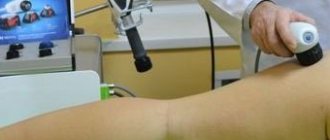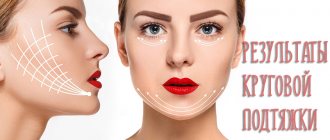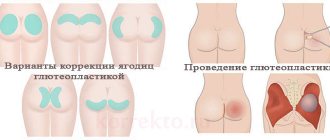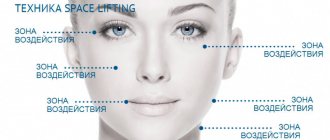Indications and contraindications for platysmoplasty
Platysmoplasty surgery is not performed for health reasons or to cure something. It has one goal - to restore the aesthetics and youth of the face and neck, so it can be performed on anyone who has no contraindications to surgical operations. Depending on the characteristics of the changes, the surgeon will choose the optimal method of operation.
Depending on the severity of visible changes in neck tissue, several types are distinguished:
- Minimal atrophy and ptosis - you can do without surgery by choosing conservative correction methods;
- Laxity is noticeable in the lateral parts of the neck - lateral platysmaplasty is indicated;
- Decreased tone of the subcutaneous muscle with noticeable hypertrophy of its inner edges - medial platysmaplasty is performed;
- Noticeable prolapse of soft tissues along with low muscle tone and laxity of the neck, leading to the formation of folds and wrinkles - combined operations are performed.
Neckplasty is indicated if:
- A “double chin” appeared;
- There is a very noticeable sagging of the skin of the neck, a clear angle between the lower part of the chin and the neck is lost, the oval of the face has changed;
- Deep wrinkles and longitudinal skin strands in the middle part of the neck are noticeable, worsening the appearance and adding age;
- There is a small chin combined with a massive neck, creating an aesthetic imbalance.
A personal desire to undergo surgery is also one of the indications. If the client wants to correct even the most minor changes and undergoes the operation safely, the surgeon will not refuse him this opportunity.
Surgery on the subcutaneous muscle of the neck cannot be performed if:
- Acute general infectious diseases or exacerbation of chronic ones at the time of surgery;
- Tumors of any location;
- Systemic pathology of connective tissue, autoimmune diseases;
- Pathologies of hemostasis;
- Diabetes mellitus;
- Allergies to drugs for anesthesia;
- Decompensated pathology of the heart, lungs, liver or kidneys;
- Pustular, eczematous skin changes at the site of proposed skin incisions;
- Too thin skin on the neck.
Platysmaplasty is also contraindicated for minors, pregnant women and nursing mothers, and people with mental illness. Against the background of smoking, it can result in complications, so the issue of bad habits is discussed in advance.
Contraindications for carrying out
Cervicoplasty is not recommended in the following cases:
- chronic, acute and infectious diseases in the acute stage;
- autoimmune and oncological diseases;
- cardiovascular diseases;
- diseases of the hematopoietic organs;
- allergic reactions;
- renal and liver failure;
- thyroid diseases.
Rehabilitation period
Usually the patient is discharged from the clinic immediately after the operation. In order for the recovery period to pass with the greatest comfort, it is worth following some rules:
- do not wear compressive clothing that affects the operated area;
- do not visit baths, saunas, or take hot baths;
- do not visit swimming pools and solariums;
- do not remove the compression bandage for a month;
- avoid intense physical activity, do not lift heavy objects;
- sleep on a high pillow so that swelling goes away faster.
In the first days after surgery, it is not recommended to turn your head to the right and left, not to open your mouth wide, and to avoid active facial expressions and emotions (do not laugh, do not cry). During these days, it is necessary to maintain absolute rest for the muscles of the face and neck. The stitches are removed after two weeks. Over the next month, the patient will experience discomfort, which will gradually disappear.
Preparing for surgery
Platysmaplasty lasts up to two hours and always requires general anesthesia, so preparation for it must be of high quality. After a conversation with a plastic surgeon and anesthesiologist, the patient is sent for an examination, including blood and urine tests, tests for HIV, hepatitis, syphilis, fluorography, ECG, coagulogram, and consultations with specialists. The therapist gives his opinion on the safety of the upcoming treatment after eliminating all possible contraindications.
Two weeks before surgery, blood thinners, hormones, and vitamin E are discontinued. Smokers should give up the bad habit at least temporarily, as it can cause regeneration problems and even complications.
At the appointed time, the patient comes to the clinic with the results of all the tests completed, the surgeon examines him again, explains the technique of the upcoming correction, and models the final result. The anesthesiologist finds out all the information regarding allergies, past experience with anesthesia, and the nature of medications constantly taken.
Preparatory stage
First of all, the patient is prepared for surgery. Preparation includes:
- consultation with a surgeon;
- comprehensive examination;
- laboratory research.
A consultation with a surgeon is necessary in order to determine the final result. The surgeon must know about the patient’s wishes, tell how the operation will take place and what result should be expected. If cervicoplasty is performed in parallel with mentoplasty (chin surgery), then it is necessary to take measurements for the manufacture of the prosthesis.
A comprehensive examination is carried out to identify contraindications and allergic reactions. If contraindications are identified, the operation is not performed. Consultation with related specialists is also necessary.
Laboratory tests include:
- general blood analysis;
- Analysis of urine;
- blood chemistry;
- HIV test;
- analysis for hepatitis B and C;
- ultrasound examination of the thyroid gland;
- fluorography of the lungs;
- electrocardiogram.
Two weeks before surgery, it is necessary to avoid the use of alcohol and nicotine, and stop taking coagulants that affect blood clotting.
Why is it important to limit or stop smoking altogether? As is known, nicotine negatively affects the condition of blood vessels and leads to disturbances in the functioning of the circulatory system. Thus, the healing of postoperative wounds will be delayed, and the rehabilitation period will last longer. 12 hours before surgery you should not eat, and in the morning before surgery you should not even drink.
Methods of platysmoplasty and its features
When performing a neck lift, the surgeon connects parts of the subcutaneous muscle in such a way as to eliminate excess skin, hide wrinkles, and improve the contours of the chin. In other cases, it pulls the muscle upward, to the behind-the-ear areas. The operation can be supplemented by lifting the lower half of the face, or combine several techniques for plastic surgery of the subcutaneous muscle. This intervention is considered one of the most technically difficult in plastic surgery.
The effect of an operation is not always easy to predict, because it depends not only on the skills and qualifications of the surgeon, but also on individual anatomical features, the patient’s age, the regenerative abilities of his tissues, concomitant pathology and other factors. Platysmaplasty gives long-term results - up to 10-15 years, but as you age, wrinkles may return again.
A neck lift requires the plastic surgeon to pay attention to certain anatomical and physiological features of the patient’s face and neck. The severity of the angle of the lower jaw and chin, the elasticity of the skin, the volume of fatty tissue in the neck, the degree of ptosis of soft tissues, and the predisposition to keloid scars must be assessed.
Platysmaplasty includes several successive stages:
- Treating the skin with an antiseptic, applying markings;
- Skin incisions depending on the chosen technique (under the chin, behind the ears, on the neck);
- Removing excess skin and fat, suturing the inner edges of the muscle, fixing the outer parts, etc.;
- Coagulation or ligation of bleeding vessels, applying a cosmetic suture, treating with an antiseptic, covering wounds with a sterile bandage.
Plastic surgeons have developed several methods of platysmaplasty, which can be used independently or combined:
- Removal of fat deposits by liposuction;
- Insulated plastic;
- Cervicoplasty;
- Radical platysmoplasty;
- Complex facial rejuvenation surgery.
Liposuction surgery is performed from an incision up to four centimeters long. Using special small-diameter tubes, the surgeon uses a vacuum to remove excess fat deposits, correcting the contour and size of the chin area. The operation is indicated for a pronounced “double chin”.
Isolated platysmaplasty is considered one of the most gentle methods, but one cannot expect a very noticeable effect from it. The operation is indicated in the initial stages of soft tissue ptosis. If there are clearly visible changes in both the neck and the face, then after isolated plastic surgery the patient runs the risk of experiencing some disharmony, so it is more advisable to choose combined methods of neck and chin plastic surgery.
Complex anti-aging surgery is indicated for a combination of age-related changes in the face, chin and neck. The operation includes platysmaplasty, facelift, chin correction with implants or lipofilling, liposuction and other techniques in various combinations depending on the patient's needs.
Cervicoplasty consists of removing skin folds from the chin area, lower third of the face and neck. Cervicoplasty is especially effective for severe sagging and sagging skin of the face and neck. A skin incision is made behind the ears or under the chin, loose skin is removed and the remaining skin is stretched.
The radical method of platysmoplasty is the most effective. It can be implemented using the lateral or medial method, as well as a combination of them. Deep platysmaplasty involves excision of fat deposits and a combination of lateral and medial techniques. After surgery, it is mandatory to wear a support bandage.
With lateral platysmaplasty, the subcutaneous muscle is peeled away from the skin, excess fat is excised, after which the surgeon makes an incision near the temple and leads it with a circumflex line behind the ear. The subcutaneous neck muscle is pulled upward and fixed behind the ears, giving the face a tighter and more youthful appearance.
Medial platysmaplasty is necessary for significant diastasis of the inner edges of the subcutaneous muscle. The surgeon makes an incision in the chin area, then tightens the muscle inward, sharpens the angle between the neck and chin, and connects the edges of the subcutaneous muscle in the middle of the neck. Skin sutures must be very neat and precise. The medial platysmaplasty technique can be combined with other techniques to improve the aesthetics of the face and neck.
medial platysmaplasty
When used independently, lateral and medial plastic techniques cannot provide an ideal angle between the neck and chin, so they are usually used in combination. This approach makes it possible to correct this zone even in those people who have crossed the fifth decade of life and have acquired visually pronounced age-related changes.
Neck lift methods: mesothreads, medial and submental platysmaplasty
Today, there are several methods of neck lift using surgery.
Let's look at the most popular of them. Each has its own characteristics and contraindications.
Mesothreads are fibers that are processed in a special way and then embedded into the epidermis.
As a result, the skin becomes more elastic and has much better tone.
Neck lift with mesothreads is one of the latest developments in the field of rejuvenation. This is a real breakthrough in aesthetic cosmetology.
Mesothreads allow you to combine four rejuvenation techniques:
- Botox injections, so-called “beauty injections”;
- filling intercellular voids;
- laser tightening;
- oxygen exposure.
The skin is rejuvenated with useful substances, and the tightening effect is achieved in the shortest possible time: mesothreads are applied within an hour. After the procedure there is no damage, as happens after injections or laser resurfacing. The most important thing is the absence of contraindications in the form of individual intolerance to the components.
Medial platysmaplasty
Platysma is a flat and very thin muscle formation that is located in the anterolateral surface of the neck and consists of two “bellies”. The appearance of the effect of drooping corners of the mouth depends on the state of platysma.
Over time, fatty tissue accumulates in the chin area and lower cheeks. The medial edges of the subcutaneous cervical muscle are called medial. Reflexively, they thicken, thus compensating for age-related changes. The lateral sections remain relaxed. As a result, the medial edges of the muscle become more pronounced.
Medial platysmaplasty involves removing fatty tissue and tightening the neck muscles, thereby significantly increasing muscle tone. This operation is performed under general anesthesia.
Submental platysmaplasty
Submental platysmaplasty is a more commonly known double chin correction. During the operation, excess fat deposits are removed and muscles are tightened, which increases their tone.
The operation is also performed under general anesthesia, like medial platysmaplasty.











